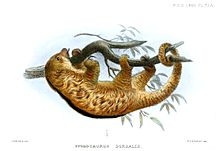- Silky Anteater
-
Silky Anteater[1] 
Conservation status Scientific classification Kingdom: Animalia Phylum: Chordata Class: Mammalia Superorder: Xenarthra Order: Pilosa Suborder: Vermilingua Family: Cyclopedidae
Pocock, 1924Genus: Cyclopes
Gray, 1821Species: C. didactylus Binomial name Cyclopes didactylus
(Linnaeus, 1758)
Silky Anteater range Synonyms Myrmecophaga didactyla Linnaeus, 1758
The Silky Anteater or Pygmy Anteater (Cyclopes didactylus) is a species of anteater from Central and South America, ranging from extreme southern Mexico south to Brazil Delta Amacuro Venezuela and possibly Paraguay. It is the only living species in the genus Cyclopes and the family Cyclopedidae.
It is the smallest member of the anteaters, with total length ranging from 360 to 450 mm (14.1-17.7 in) and usually weighing less than 400 g (0.88 lbs). It has a dense and soft golden brown fur, short snout, partially prehensile tail and two very enlarged claws in each forepaw.
Contents
Subspecies
There are six recognized subspecies:
Cyclopes didactylus catellus - Thomas, 1928
Cyclopes didactylus dorsalis - Gray, 1865
Cyclopes didactylus eva - Thomas, 1902
Cyclopes didactylus ida - Thomas, 1900
Cyclopes didactylus melini - Lönnberg, 1928
Cyclopes didactylus mexicanus - Hollister, 1914
Natural history
It is a nocturnal and arboreal animal,[3] found in lowland rainforests with continuous canopy where they can move to different places without the need to descend from trees.[3] It can occur at fairly high densities of 0.77 individuals/ha, for example, in some areas. Females have smaller home ranges than males.
The Silky Anteater is a slow moving animal and feeds mainly on ants, between 100 and 8000 a day.[3] Sometimes it can also feed on other insects, such as termites and small coccinellid beetles.[3] The Silky Anteater defecates once a day.[3] Some of those feces, examined by scientists, showed a large quantity of exoskeleton fragments of insects, indicating that the Silky Anteater does not possess either chitinase or chitobiase,[3] digestive enzymes found in insectivorous bats.
It is a solitary animal and gives birth to a single young that is usually placed inside a nest of dead leaves built in tree holes.[3]
Some authors suggest that the Silky Anteater usually dwells in silk cotton trees (genus Ceiba).[3][4] Because of its resemblance to the seed pod fibers of these trees, it can use the trees as camouflage[3] and avoid attacks of predators such as hawks and, especially, harpy eagles. During the day they typically sleep curled up in a ball. Although they are rarely seen in the forest, it is said that they can be found more easily when they are foraging on lianas at night.
When threatened, the Silky Anteater, like other anteaters, defends itself by standing on its hind legs and holding its forefeet close to its face so it can strike any animal that tries to get close with its sharp claws.[3]
-
Silky anteater sleeping, Damas Island, Costa Rica
References
- ^ Gardner, Alfred L. (16 November 2005). "Order Pilosa (pp. 100-103)". In Wilson, Don E., and Reeder, DeeAnn M., eds. Mammal Species of the World: A Taxonomic and Geographic Reference (3rd ed.). Baltimore: Johns Hopkins University Press, 2 vols. (2142 pp.). p. 102. ISBN 978-0-8018-8221-0. OCLC 62265494. http://www.bucknell.edu/msw3/browse.asp?id=11800028.
- ^ Chiarello, A., Miranda, F., Samudio, R. & Members of the IUCN SSC Edentate Specialist Group (2008). Cyclopes didactylus. In: IUCN 2008. IUCN Red List of Threatened Species. Downloaded on 28 November 2008.
- ^ a b c d e f g h i j Bartoz, Suzy, and Anthony Cerda. "Silky Anteater." Benedictine University. 2009. Benedictine University. 16 Aug. 2009 http://www.ben.edu/museum/silky_anteater.asp
- ^ "Silky Anteater." WildMagazine.Ca. 16 Aug. 2009 http://www.wildinfo.net/facts/Silkyanteater.asp
- Louise H. Emmons and Francois Feer, 1997 - Neotropical Rainforest Mammals, A Field Guide.
- Eisenberg, J.F. and Redford, K.H. 1999. "Mammals of the Neotropics, Volume 3: The Central Neotropics: Ecuador, Peru, Bolivia, Brazil". University of Chicago Press.
- Best, RC; Harada, AY, 1985 - Food habits of the silky anteater (Cyclopes didactylus ) in the central Amazon. Journal of Mammalogy 66(4).
External links
- Photos of Silky Anteaters on the Web: 1, 2, 3
- http://www.natureserve.org/imagerepository/GetImage?SRC=6&BATCH=49&FMT=gif&RES=600X615&NAME=cyclopes_didactylus Map of Silky anteater's range (Natureserve.org)]
Extant Pilosa species by suborder Bradypodidae Megalonychidae Cyclopedidae CyclopesSilky Anteater (C. didactylus)Myrmecophagidae CategoryCategories:- IUCN Red List least concern species
- Anteaters
- Myrmecophagous mammals
- Mammals of South America
- Mammals of Central America
- Mammals of Costa Rica
- Monotypic mammal genera
- Animals described in 1758
-
Wikimedia Foundation. 2010.



